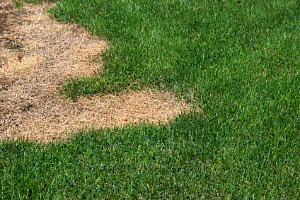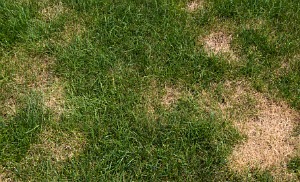Lawn diseases are usually not a major pest/problem of home lawns. They are more likely to cause trouble in highly maintained turfgrass areas such as golf courses and sports fields. When a disease causes extensive damage to a lawn it is most likely a sign that something is out of balance and maintenance practices need to be reviewed.
- Living or Non-Living Damage?
- Disease Development and Spread
- Diagnosis, Management and Control
- List of Turfgrass Diseases and Host Species
- Help and Questions
Lawn diseases are, for the most part, caused by plant-parasitic fungi. However, a disease can be defined as any abnormal condition that results in the decline or death of grass plants. Therefore, disease symptoms can be caused by either abiotic or biotic agents. Abiotic agents are non-living or non-parasitic while biotic agents (pathogens) are living organisms that are parasitic.
Abiotic Damage

A common reaction to turfgrass injury is to place the blame on an insect or disease-causing organism. In many cases, injury or decline is from a non-living source.
Examples of abiotic injury/agents include soil compaction from heavy traffic, nutrient deficiencies or fertilizer burn, over-watering or drought, animal damage such as dog urine, gasoline spills, salt damage from ice melt chemicals, and herbicide misapplication. Often, abiotic lawn diseases can be corrected by simply changing or improving maintenance practices.
Biotic Disease Agents

Biotic agents include plant-parasitic fungi, bacteria, viruses and nematodes. These pathogens have the ability to reproduce and spread from diseased to healthy plants.
All of the major grass diseases are caused by plant-parasitic fungi.
Plant-parasitic fungi are simple organisms that feed on plants. The fungi cannot produce the nutrients needed to survive, so they basically steal it from the host causing decline and disease symptoms to appear. These fungi are highly specialized and parasitic to specific groups of plants.
Occasionally, bacteria or viruses will cause a lawn disease but these are rare. The most common is St. Augustine Decline — this disease is caused by a virus and is specific to St. Augustine grass.
Nematodes are microscopic worm-like organisms that occur naturally in all soils. Nematodes can be either beneficial or parasitic to plants — feeding on roots. Most of the time, damage from plant-parasitic nematodes goes unnoticed. On rare occasions, populations are high enough to cause injury. Affected plants show symptoms of wilt, stunted growth, or are off-color.
Disease Development and Spread
Three things are needed for a lawn disease to develop: a disease pathogen, a susceptible host, and environmental conditions that favor the development of the disease. This interrelationship is known as the Disease Triangle.
Plant Disease Triangle
Fungi can spread from an infected plant to neighboring plants by vegetative growth called mycelium. They also reproduce by large numbers of spores that originate from specialized structures called fruiting bodies. Fungal spores are abundant and widespread. They are spread in a variety of ways including: air, rain, irrigation, lawn maintenance equipment, insects, or animals transporting them from infected plants to healthy plants.
When a fungal spore contacts a host plant and environmental conditions are favorable for spore germination, a disease is likely to develop.
Turfgrass disease control involves managing the disease triangle. This is accomplished by:
- Understanding the environmental and lawn maintenance factors that affect disease development.
- Cultural Control – improving the health and vigor of your lawn by using proper lawn care practices including: mowing, watering, and fertilizing.
- Chemical Control – fungicide applications should only be used as a last resort. If disease spreads and damage occurs at unacceptable levels, fungicides can be applied on a curative basis to suppress the disease.
A healthy, vigorous lawn is the best disease prevention. A Smart Lawn Plan will help you grow a healthy, green lawn without harsh chemicals. Kid, pet, and environmentally-friendly lawn care.
Lawn Disease Diagnosis, Management and Control
Most of the time we don’t even notice grass diseases because they are minor. A healthy lawn has the ability to recover from damage by outgrowing it. When disease injury is noticeable and even threatens to destroy a lawn, I recommend taking the following steps:
1. Identify the grass type and determine what is normal.
Know your lawn and understand the grass species you are growing. Each grass species has a specific complement of diseases and will react to environmental and lawn care activities in its own way. Examine healthy lawns of the same grass type to determine what “normal” looks like. Make sure you are following proper maintenance practices.
2. Determine if injury is caused by an abiotic or a biotic agent.
Under what circumstances and when did the disease appear? What is the recent history of the site? List recent lawn maintenance practices such as watering, fertilizing, and herbicide applications. Has there been any extreme changes in the weather such as a sudden hard frost?
How did the disease develop? Did it appear overnight? Is it spreading? Or did it start in one spot and progress slowly? Abiotic injury does not spread and will often appear suddenly. The edges of the damage are usually well-defined. Damage caused by a fungus or insect will usually start in one area and spread throughout the yard.
Get on your hands and knees and take a closer look. Look for signs of insect feeding, fungal mycelium, fruiting bodies, or lesions on the leaves. Leaf blades will show symptoms of disease or insect damage. The symptom is usually specific to the pest.
Disease symptoms include small or large patches of off-color, circular grass in the lawn and spots (lesions) on the grass blades. Fungal mycelium is usually present in the early morning when the lawn is wet with dew.
3. Identify the disease.
The table below lists common lawn diseases along with the host species that they infect. The links will take you to an N.C. State University Turffiles web page where you will find a detailed description and photos of the disease.
If you are having trouble identifying the disease or the cause of injury, ask for help at your local Cooperative Extension office or call a lawn care professional (find a local lawn service).
The Turffiles web pages are a valuable resource. Cultural and chemical disease management and control options are listed along with the detailed descriptions and photos.
4. Decide how to manage or control the disease.
Once you have positively identified the disease (or cause of damage), research the environmental conditions that promote disease development and then determine the best way to manage the disease.
Visit the Lawn Disease Help Area if you would like our input.
Lawn Diseases and Susceptible Grass Species
| Turfgrass Diseases | Host Species |
|---|---|
| Brown Patch | bentgrass, Kentcky bluegrass, fescues, perennial ryegrass |
| Brown Blight | perennial ryegrass |
| Damping Off | bentgrass, bluegrasses, fescues, ryegrasses |
| Dollar Spot | All species |
| Fairy Ring | All species |
| Grey Leaf Spot | tall fescue, perennial ryegrass, and St. Augustinegrass |
| Grey Snow Mold | bentgrass, bluegrasses, fescues, ryegrass |
| Large Patch | bermudagrass, centipedegrass, seashore paspalum, St. Augustinegrass, zoysiagrass |
| Leaf Spot/Melting Out | Kentucky bluegrass, bermudagrass |
| Pink Snow Mold | bentgrass, bermudagrass, Kentucky bluegrass |
| Powdery Mildew | Kentucky bluegrass, fine fescue, perennial ryegrass |
| Pythium Blight | bentgrass, Kentucky bluegrass, fescues, perennial ryegrass |
| Pythium Root Rot | All Species |
| Red Thread | Kentucky bluegrass, tall fescue, fine fescue, perennial ryegrass |
| Rust | Kentucky bluegrass, tall fescue, St. Augustinegrass, zoysiagrass |
| Slime Mold | All Species |
| Spring Dead Spot | bermudagrass, zoysiagrass |
| Summer Patch | creeping bentgrass, Kentucky bluegrass, fine fescue |
| White Patch | tall fescue |
| Yellow Patch | creeping bentgrass, Kentucky bluegrass, tall fescue |
| Yellow Tuft or Downey Mildew | bentgrass, Kentucky bluegrass, zoysiagrass |
Lawn Disease Help & Questions
If you are having trouble with lawn damage and would like our input, this is the place to get help. Simply gather the recommended information and fill out the form below.
To help us help you, we need as much info as you can supply. Please include the following:
- Where you live (city and state).
- Types of grass growing in your lawn.
- Recent environmental history (temperature extremes, dry, cold, rainy).
- Site conditions (sunny/shady, heavy traffic, soils, etc.)
- Describe the symptoms in detail. What are you seeing overall and up close?
- Take some pictures including close-ups and overall damage. Pictures help us visualize the problem.
Disease Diagnosis and Help Topics
Click on the links below to view and comment on topics.
Rust on Lawn, Kentucky Bluegrass Sod
QUESTION: (Fall 2011) We have a 3yr old established sod lawn. Every time we mow we have orange dust on our mower, orange shoes and our white dog has …
